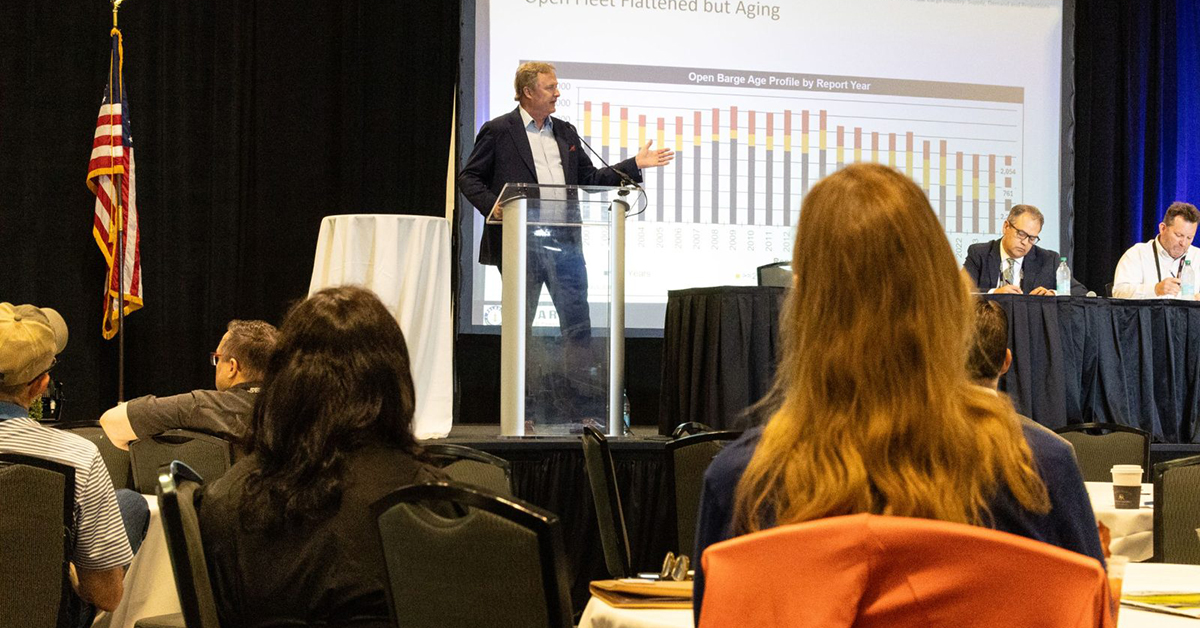Attendees at this year’s Inland Marine Expo (IMX) got an in-depth look at the barge industry thanks to a keynote session titled “The State of the Barge Industry: Supply, Demand and Projections.” The session featured moderator Ken Eriksen, managing member and strategic adviser for Polaris Analytics and a regular contributor to The Waterways Journal, Mike Steenhoek, executive director of the Soy Transportation Coalition, and Clark Todd, president and CEO of Blessey Marine Services.
Eriksen began with the “three Rs “of the 2024 inland barge fleet data: retirement, replacement, resurging. All three types of the most common barges in the fleet are aging—dry covered, dry open and tank barges. Dry covered barges number 13,379, a record number that is holding steady. Dry open barges number about 5,000 and are steadily declining, while the number of tank barges have flattened out at 4,000. The barge fleet faces a “retirement cliff,” Eriksen said, even though some covered barges can be switched to open as they age. About 2,800 tank barges are less than 20 years old.
Barge construction dropped after 2016, Eriksen said, while grain and soybean exports have been rising for three years in a row, even though 2023 saw a drop of 11 million tons in grain exports. Last year’s grain exports are the fifth largest in history by volume, and 2025 is forecast to be another record year despite trade tensions.
“Corn exports are driving the [export] show,” Eriksen said, although low water diverted some barges last year.
The continued drop in coal numbers is a big factor in domestic barge movements, Eriksen said. In 2016, 1.2 billion tons of coal was produced in the United States, versus less than 600 million tons last year. Coal exports remain relatively strong, but in terms of volume they are “just a freckle” compared to domestic declines. However, domestic petroleum consumption and barge movements are near pre-COVID levels.
So where and when is the “resurging” going to come in? The demand is there, Eriksen said, with multiple options for exports to get to markets and barge transportation still offering the best value.
Steenhoek began his presentation by quoting hockey great Wayne Gretzky, who famously said he “skates to where the puck is going.” The problem for exporters, Steenhoek said, referring to current trade and tariff policy, is that they don’t know where “the puck” is heading.
“That’s what ag is confronting now, a reluctance to make bold investments in this unpredictable environment,” he said. “On the economy, predictably good is better than sporadically great.”
Steenhoek said he understands and agrees with the Trump administration’s trade goals, but it’s also important to note that “U.S. farmers sell soybeans to China.”
Steenhoek often hears that the United States can or should “just find other customers.” But as an export market, China cannot be replaced easily or quickly. Of course, soybean growers and other ag exporters are doing their best to diversify their overseas markets, he said, but China is unique with its huge population, a large and growing middle class with a huge appetite for pork and chicken, and cooking methods that use a lot of oil. Other large markets, like India, are on the rise, but they can’t replace China.

Todd rounded out the panel with an overview of the liquid barges sector. Todd said the liquid barge market has seen dramatic change since 2000, with the tank barge fleet almost doubling since then. And while towboats can be “resurged” by repowering and refurbishing, barges do reach the end of their lives and eventually need to be retired and scrapped. After 2026 or 2027, a “significant” number will need to retire over 10 years, Todd said.
Todd noted that, since 2000, 20 shipyards have closed, including Jeffboat, the largest builder on the inland waterways.
“We’ve lost a lot of barge-building capacity,” Todd said.
In 1975, the United States had about 200,000 shipyard workers, while by 2010 that number had shrunk to 154,000. The United States is still technically ranked fourth in the world shipbuilding market (behind China, Korea and Japan), but only 0.2 percent of the world’s ocean-going vessels are built in the United States versus a 5 percent share in the 1970s.
“How did we get here?” Todd said. “What happens in Washington D.C. has a lot to do with it.”
In 1982, President Ronald Reagan ended direct federal subsidies for shipyards, though the Trump administration is discussing reintroducing those.
During Q&A, Steenhoek said American farmers are the ultimate “made in America” constituency.
Regarding trade policy, Steenhoek said, “Our concern is not with the goals” of the current trade measures “but their implementation.” Trade policy shifts “need a long runway.” Echoing Steenhoek, Todd said that oil and gas opportunities also need a “long flight path.”
“‘Made in America’ is a good story to tell, but in oil and gas, we need the price to be right as well,” Todd said.
Todd noted the encouraging signs of the SHIPS for America Act and the president’s April executive order designed to revive American shipbuilding.
Featured image caption: Ken Eriksen with Polaris Analytics speaks during the State of the Barge Industry session during this year’s Inland Marine Expo. (Photo courtesy of Event Coverage Nashville)




